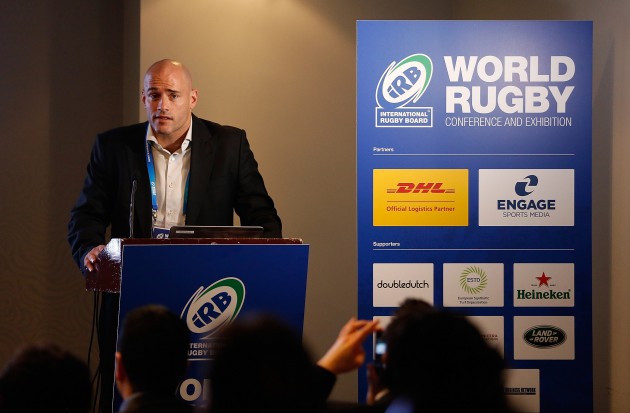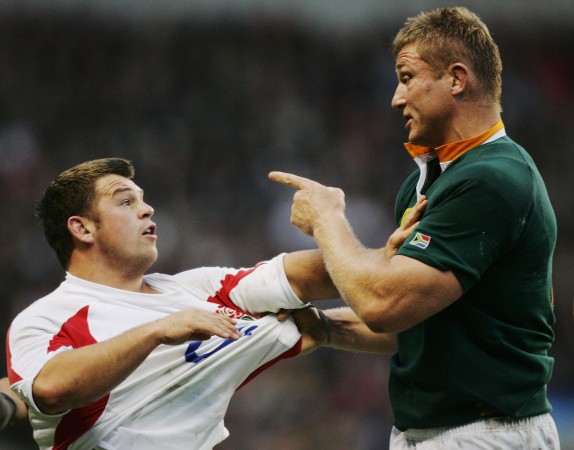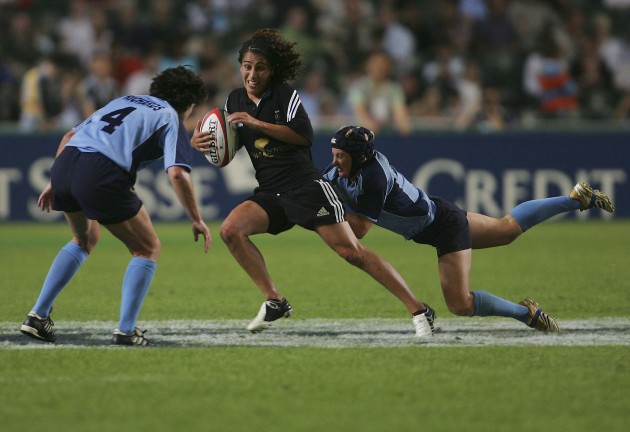In the April 2014 edition of Rugby World, we ran the below investigation into the state of doping in rugby. England have filed their annual report since then, but the issues are still relevant.
IN MAY 2013, during a Scottish training camp in the lead-up to the Junior World Cup, Melrose fly-half Sam Chalmers was pulled in for a random drugs test – his first drugs test. He gave his urine sample and tried to get on with training. Five weeks later, whilst in the gym, he got the bad news from the SRU: he had failed his test.
Chalmers’s story is one that we rarely see in international rugby. A player from one of the IRB’s (now World Rugby) top-ranked nations fails a drugs test and it is not for recreational drugs but for a performance-enhancing substance.
Following his positive test, which found the anabolic androgenic steroids stanozolol and methandienone in his system, Chalmers confessed, telling World Rugby’s panel that he had purchased some pills online known as Pro SD in an effort to bulk up. “When the season finished a friend of mine who isn’t involved with rugby told me about it and I stupidly took two weeks’ supply,” the 19-year-old told World Rugby.
Last December he told an assembled group of young international athletes from the Scottish Borders and a reporter from the Daily Mail about his idiocy and embarrassment. After years of being told he needed to get bigger and more physical, the slight, diabetic back turned to a quick fix; a magic pill taken only weeks before entering an international camp. He was banned for two years.
This cautionary tale made headlines because the young player is the son of ex-Scotland and Lions fly-half Craig Chalmers. It has sent ripples through the amateur game in Scotland. In late September (2013), BBC Scotland ran a story with a 19-year-old playing in the country’s National League who claimed: “Lower leagues? I’d say roughly two people per team are on some sort of substances, a fat-stripping or a bulking supplement or something like that. From the Premiership to the Championship.”
THERE COULD be questions raised about why so few big names have been caught in the anti-doping net like Chalmers. Why have no superstars tested positive for performance-enhancing drugs? Certainly there has been some opportunity given the number of tests done by World Rugby and WADA.
Of course, World Rugby’s remit does not extend to national club competitions. The loose-knit community of international unions are overseen by World Rugby and unions’ own leagues are looked after by themselves, with testing in England, Scotland and Wales overseen by UK Anti-Doping (UKAD) and the Irish Sports Council looking after testing in Ireland.
Andy Parkinson, the chief executive of UKAD, has praised World Rugby’s proactive approach to education, which he sees as an important part of the fight against doping. “There is an element of naivety on this subject,” Parkinson tells Rugby World. “You hear people say ‘not in my sport; not in my country.’ But we in the UK aren’t any different. We also see rugby union as having a high risk of potential doping, but we see education as being excellent, with both the IRB (World Rugby) and the RFU. We work with them all around the country, even abroad, testing blood and urine.”
Yet it is not all rosy in rugby’s garden, and Parkinson does have stark words. “Doping won’t go away just because you test a group of athletes,” he says. “It is not a fight that we can ever say we’ve won and although we have some relative successes, by the very nature of sport you are going to have athletes who try to cross the line. Things are better than even ten years ago but if people want to cheat they will.
“Doping’s a threat to all sports and with widely available pharmaceuticals or with more sophisticated products coming out, we have to keep pace and work on new measures. We also have to drive through the right moral compass.”
This may paint a gloomy picture, but Professor David Cowan believes things are not so grim. He is director of the Drug Control Centre at King’s College, London – the site that oversaw testing during the London Olympics in 2012 and where Sam Chalmers’s sample was tested in May last year.
Cowan says: “We’re busy. There are new research programmes being executed. I’m very optimistic. When WADA came onto the scene we were operating more on charity, but there is more money going into research. This is a tough job, but a good one.”
And on the myth of cheats being one step ahead? “Well, it is better if (performance-enhancing substances) weren’t taken, but our concern is making sure pharmaceuticals are not harmful. WADA-funded research is important to make sure we are at the forefront.”
Both parties can agree that money plays an important role. However, one thing Parkinson and UKAD are keen to stress is the human element. “We don’t like prosecuting athletes, but we have to,” he says. “It’s hard for national federations like the RFU, performing a dual role. We test, investigate, sometimes prosecute. But we cannot fight against doping without the help of athletes, coaches, governing bodies and parents as well.
“We’ve had instances where we’ve prosecuted and another athlete has said, ‘I could have told you about that.’ We have an anonymous hotline for tips and we would urge athletes to use it if they know anything. We won’t disclose anyone’s identity.”
IN THE course of looking into doping in rugby a handful of elite players, some still competing and some recently retired, were approached to discuss the issue. While some mentioned rumour and persistent changing-room jokes, no source was willing to be quoted, even anonymously, for fear of being recognised.
While there is no accusation of any top players doping in this report, there is still an unspoken omertà, where competitors will not risk being the whistleblower or pointing out how authorities can better help athletes or monitor their health. And there are risks in stepping forward.
It didn’t make headlines in the UK and Ireland, but in the second half of 2013, a former French international landed in hot water. Former France, Racing Métro and Harlequins prop Laurent Bénézech told the newspaper Le Monde that he believed the retirement of Bayonne back-row François Carillo last season due to a heart condition was linked to the use of Human Growth Hormone (HGH). Carillo strenuously denied the allegation and Provale, the players’ union in France, labelled it insulting to all involved, filing a defamation case against Bénézech.
In the month before Provale filed their case, Bénézech also appeared before a senate of the Committee of Inquiry on anti-doping in France. There he alleged that he had been given cortisone against his knowledge during the 1995 World Cup. He presented no proof at this hearing, and has not shown any fresh findings to Provale to date.
Bénézech also cast doubts on 2006 Heineken Cup losing finalists Biarritz at the hearing, claiming there was a relationship between several players and one-time Pau and Argentina conditioning coach Alain Camborde, who was found guilty of trafficking doping products – including the WADA-banned substance clenbuterol and some anabolic steroids – and received a suspended three-month sentence. Camborde moved to bring another defamation suit against Bénézech in September, but later dropped the case.
Bénézech is not the only former France international to say doping had taken place. Last April (2013) Jean-Pierre Élissalde, a five-cap No 9, claimed to have taken amphetamines twice in his career and that “there were other forms of doping, notably to be able to work harder and put on muscle,” during the 1970s and 1980s. This did not cause an international, or even national, scandal.
If there was indeed some grand conspiracy, Bénézech has not found any proof to support his theory. Even Éllisalde is at pains to point out that there was no cabal, no ring of coaches and administrators brandishing needles when he played. It was, he said, an individual choice and since he has become a coach he has seen no evidence of strategic team doping.
THE WHISTLEBLOWING issue becomes hard if there is no organisation or programme to rail against, only individuals and rumours. It could be professionally dangerous or worthy of ridicule for a player to do so if there are only whispers or suspicions about a team-mate. Much is left to the testers.
At the top of the game in the higher-tier countries, testing is as up-to-the-minute as the sport can offer. Adding tests and breaking out from the specific testing ‘menu’ offered by WADA is expensive to administer.
“Adding tests into the matrix means that we may not be able to do more tests overall,” says Stephen Watkins, the RFU’s anti-doping and illicit drugs programme manager. He cites the example of Erythropoietin (EPO), the red blood cell boosting drug so associated with cheating in cycling, as one where cost must be weighted against probability of cheating.
“The example of EPO is a good one. We do test for that, but not always. It’s actually a call by UKAD; we say we want to test for that but don’t tell us. We see Human Growth Hormone as more of a risk than EPO, which is used to get up and do it all again. We ask players to play for 80 minutes, once a week. We don’t ask them to get up and do it on a Sunday, too. So when you are working with a finite budget compromises have to be made.
“With EPO, it’s more difficult to detect but our players only run for 25 to 35 minutes a game. I’m not saying it couldn’t be used in union, but you could be a wing and not see a ball all day. Something like HGH increases muscle mass, decreases body fat, and while the affects could be to make your fitness go down, in rugby you are looking at an increase in strength, mass, power. If you’re going to dope we see steroids and HGH as where you are going to do it. That’s what you look for, plus some EPO tests.”
Watkins feels that some of the guesswork is removed from testing at the top using data. With rugby so varied, flankers involved a lot while wings may only do a few sprints a game, GPS-tracking data taken from World Rugby and power data from players can help tailor testing as much as budgets will allow.
In the perfect world, Watkins would like to see an increased budget push testing down the levels to act as a deterrent. Some testing has been taken from the Aviva Premiership and Championship and into the National Leagues. And just this season around 100 tests have been dedicated to Elite Player Development Groups and academy players. Around a third of those who could be tested will be, though Watkins would like this number to increase.
Among all of this, Watkins feels education is increasingly important in an age of widely available supplements. He isn’t the only one.
Andy Parkinson lays it out there: “With six packs and tight T-shirts being desirable, we are in the age of normalising supplements.
“You walk into a supermarket and there are tubs of creatine in the corner. These aren’t issues for elite athletes, but everyone else. Now, there are a whole variety of reputable companies with clean production lines making supplements, but there is no one monitoring the internet. Someone could do wonderful things in sport, but they have a decision to make.”
Former Wales and Lions wing Dafydd James backs this up.
“I remember finishing a weights session around five years ago,” he says. “We came out into the car park and someone was selling ‘stuff’ out the boot of their car. I don’t condone drug use and I don’t know anyone stupid enough to try it, but maybe sometimes we take education for granted and temptation is always going to be there for shortcuts.” For the amateur player this is an ill few have the means to fight and even fewer are aware of.
In 1997 Springbok lock Johan Ackermann received a two-year ban after nandrolone was found in his urine sample. Talking to Rugby World, the head coach of Super Rugby’s Lions explained that he had taken the banned substance on advice to help him recover from a knee injury.
Ackermann now fears that a younger generation of South Africans are just as likely to take shortcuts. “The other challenge out there is for junior players. The pressure from coaches and parents to perform, to be the best or have the best school team is tremendous, then youngsters see their heroes on TV looking pumped up. They believe that they must use something to also play at that level and have the same look.
“Unfortunately talent and natural DNA will always win and the kids don’t know that. They are not willing to work hard and follow a good diet, and would rather have something to gain weight fast.
“The focus area on educating the kids can increase at school level and all the medical risks of doping can be highlighted more. I’m not sure how it works in the UK but school kids can’t be tested at random in South Africa and that must change, as the focus for doping must move to the ages 16 to 21. If those kids know they will be tested then maybe fewer will take the chance.”
SARU are legally only able to test school players in designated periods, namely the famous national provincial youth weeks: the U16 Grant Khomo Week, SARU U18 Academy Week and U18 Craven Week.
SARU medical manager Clint Readhead reiterates the need for education, saying: “We pay a lot of attention to anti-doping strategies but it is an issue that is far from limited to rugby or even sport in general. A recent survey of schools in KwaZulu Natal suggested that 63% of schoolchildren who admitted that they had taken steroids or would consider taking a steroid did so or would do so, not to improve performance but simply to look good; nothing to do with sport.
“All of this has been fuelled by the availability of banned substances over the internet and current cultural influences.”
STEPHEN WATKINS tells a tale of the Hove RFC scrum-half who admitted his guilt to the authorities after telling his team-mates he had tried to bulk up with pharmaceutical help. His friends, disgusted with his actions, contacted the RFU and the player took his ban with good grace.
This is an example of rugby’s culture triumphing over cheating. However, this is an isolated case of one amateur going to his team-mates to see if anyone else was taking banned substances. Testing does not go on at that level. It is easy for someone to stumble into an ill-educated choice, even higher up the levels.
Sam Chalmers was caught out taking his Pro SD pills. New Zealand’s Lavinia Gould, who failed a drugs test after playing South Africa in the Women’s World Sevens Series, claimed to have taken a supplement called Jack 3D. In 2006 Argentina’s Martín Bustos Moyano failed a test at the U21 World Cup in France, stanozolol found in his system. He tried, and failed, to prove that a supplement called Glutamina was the reason for his failed test. He was banned for 18 months.
With Bustos Moyano, there is a sense of reinvention. Now at Bayonne, the back-three player was capped by the Pumas in 2008, two years after his ban. He last played for Argentina in June 2013.
In this respect players like Chalmers have hope. The Scot will be 21 when he is allowed to play rugby again. He can start over. However, due to a change in regulation by WADA, any athlete with a positive test as of 1 January 2015 will be banned for four years rather than the current two, effectively ending many rugby careers altogether.
The kid gloves are off.
This feature originally appeared in the April 2014 edition of Rugby World. To subscribe to the magazine, visit po.st/RWSub









